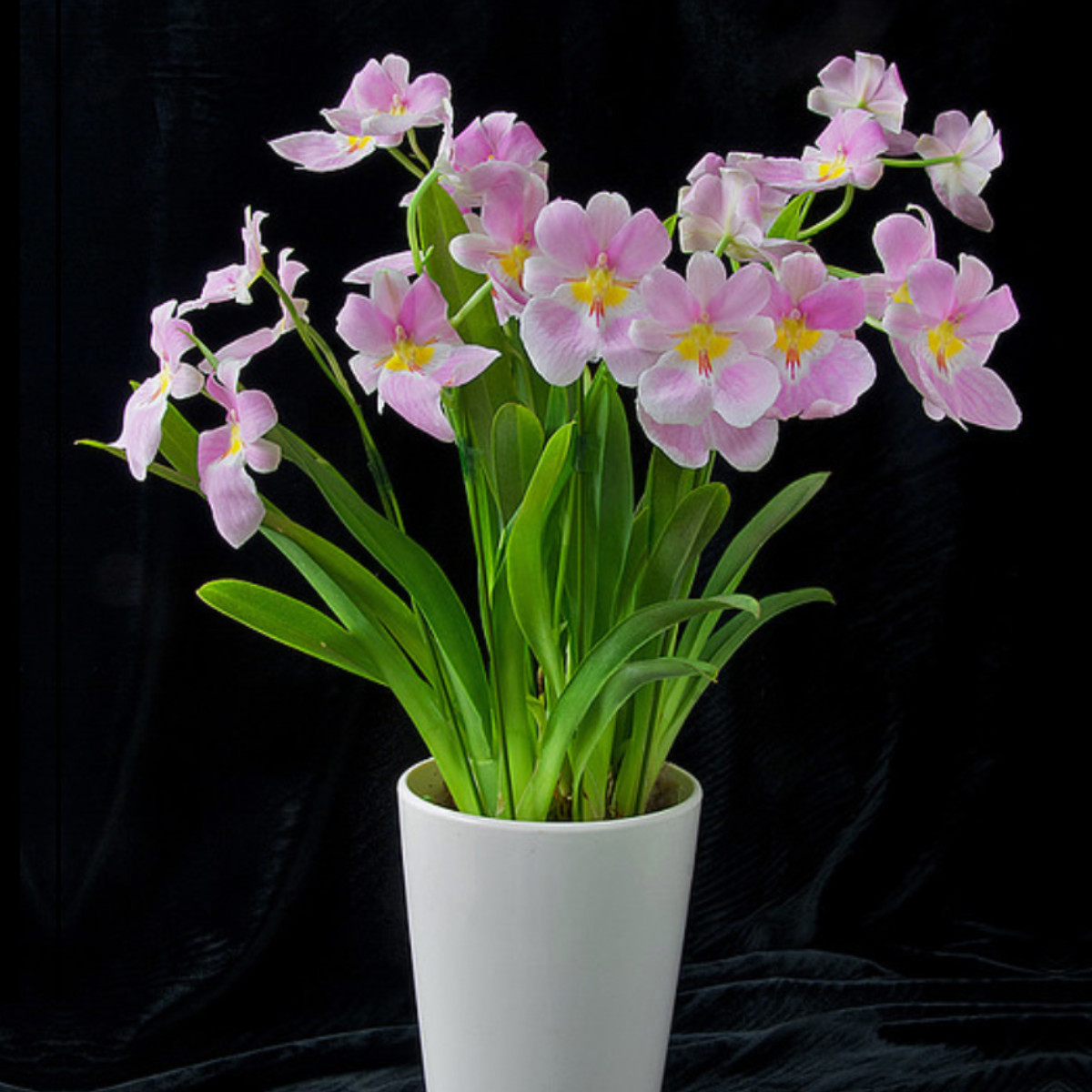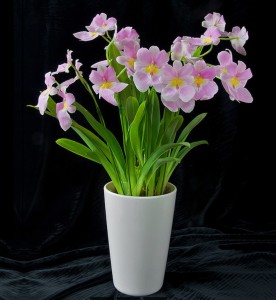Common name: The Flag-Like Miltoniopsis, Pansy Orchid
Family: Orchidaceae
Synonymous: Miltonia vexillaria var. leopoldii
Miltonia vexillaria var. rubella
Miltonia vexillaria var. stupenda
Odontoglossum vexillarium
Distribution and habitat: Miltonia vexillaria is a species of epiphytic orchid founded in isolated patches in the central mountain region of Colombia. It grows on the margins of mountain forests.
Description: Miltonia vexillaria has pseudobulbs up to 6cm (2 inch) tall, each bearing at least three strap-shaped leaves 20-30cm (8-12 inch) long. Flowers stalks grow to 50cm (20 inch) tall; several flowers stalks may be produced at one time from each pseudobulb. The stalks are each topped by three or more notably flattened, fragrant flowers each about 8cm (3 inch) across. Flower colour is pale lilac to rosy red, with the large lip (up to 7cm (2.7 inch) across) darker in colour than the rest of the flower and with a prominent yellow crest.
There can be up to eight flowers per stalk, each flower usually lasting about four weeks. A large plant with many spikes can be in bloom for three months. Their peak flowering season isspring to early summer with a smaller spurt in autumn.
Houseplant care: Miltonias do not have a rest period, growing all year. Still, short winter days will slow them down. That is when watering should be reduced and no fertiliser applied.
A healthy plant kept in right condition will speak for itself. The mature plants should make abundant growths, strong, wide leaves and push two new pseudobulbs from every old one.
Light: Miltonia vexillaria do best in medium light for most of the year. Too much bright light will turn the thin foliage yellow. During the short-day winter months, however, give plants bright light with 2 or 3 hours a day of direct morning or late afternoon sun.
Temperature: Keep the daytime temperature at about 21C (70F) and the nighttime temperature at about 18C (64F). Do not permit the temperature to rise above 24C (75F) or to fall below 17C (63F) at any time. High humidity is essential; ideal humidity range is 50 to 90%. It is a good idea to stand plants on trays of moist pebbles and mist-spray daily.
Water: Water moderately, allowing the top centimetre (0.4 inch) or so of the mixture to dry out before watering again. It is best to water early in the day so that the foliage is dry by nightfall.
As winter approaches, keep the plant mixture moist, but not damp. In the winter reduce watering, but do not let the mixture dry out.
Fertilising: Provide high-nitrogen foliar feed with third or fourth watering during the warmer months and every six to eight waterings at all other times.
Potting and repotting: Use any recommended potting mixture for epiphytic orchids - well drain potting mixture such as fine fir bark with perlite. Grow each Miltonia vexillaria in the smallest pot that will allow for further growth of two or three pseudobulbs. Repot only when necessary. The best time for repotting is in summer immediately after flowering.
Propagation: When a plant becomes inconveniently large, divide it in summer by cutting through the rhizome, making sure that each segment retains at least two pseudobulbs. Plant segments in the smallest suitable pots of moist potting mixture. Keep the pots in medium light and do not water apart from daily light mist-spray during the first four weeks. Thereafter, treat each young plant as a mature Miltonia vexillaria.
Miltonia vexillaria can be propagated by seed as well, but this procedure is not recommended for amateur grower. It takes about 9 12 months for a seed pod to mature. Then it will take about three months for the seed to germinate in the first flask. After that, it usually takes at least two years in different replated flasks before the baby plants can go into community pots. After 6 to 12 months, they can be potted up separately and then it will still be two to three years before first flowers are expected to appear. So, altogether, it will be at least five years from pollination to the first blooming- that with luck!
Problems:
Remove dying flowers and leaves without delay. If they come into contact with healthy leaves, these may be blemished.
Black spots on leaves indicate that the temperature has fallen too low.
Treatment: Either raise the temperature or decrease the humidity.
Aphids like to suck the young buds and flowers dry, but they can easily be washed off with plain water.
Recommended varieties:
Miltonia vexillaria 'Volunteer' has lavender pink flowers which are veined with deep purple and have a white and yellow blotch on the lip.
SUMMARY:
CHARACTERISTICS:
Foliage green
Features flowers, fragrance
Shape upright
Height: 45-60cm (18-24 inch)
PROPER CARE:
Watering in active growth period moderately
Light medium
Temperature in active growth period min 18C max 24C (64-75F)
Humidity high
Hardiness zone: 11
Begonia propagation f...
Essential Nutrients f...
Portulacaria afra
Tillandsia recurvata
Tillandsia stricta
Columnea microphylla
Clivia miniata
Cleyera japonica
Clerodendrum thomsoni...
Cleistocactus strausi...



